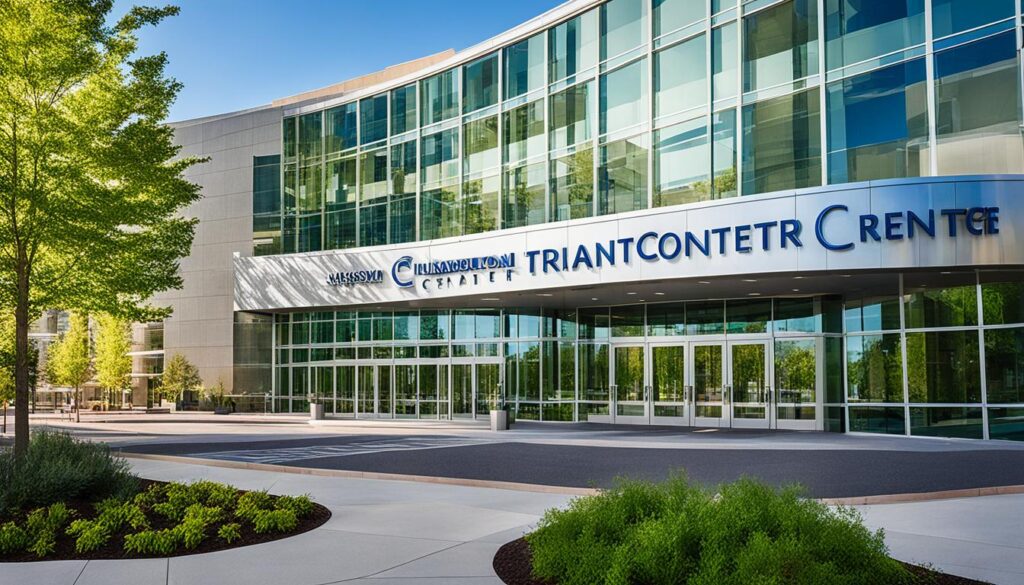The liver is the largest internal organ in the human body. It has several important jobs, including processing nutrients, medications, and hormones, as well as removing bacteria and toxins from the blood. The liver helps to regulate some of the most important bodily systems, but when it’s not functioning properly, it can be detrimental to your overall health. When patients are suffering from the complications of liver disease, many opt to have the organ removed and replaced with a healthy one. This procedure is known as a liver transplant and is one of the best treatment options for patients living with these kinds of conditions. Using Definitive Healthcare’s Atlas All-Payor Claims product, a list of the top 10 hospitals that performed the most liver transplants in 2023 has been compiled. In 2023, Cleveland Clinic Main Campus performed the highest percentage of liver transplants in the U.S., accounting for 6.2% of total transplants nationwide. IU Health Methodist Hospital performed the second highest number of liver transplants by percentage, accounting for 6% of all liver transplants in the U.S. in 2023. Piedmont Atlanta Hospital rounded out the top three, accounting for 5.5% of all U.S. liver transplants in 2023.
Key Takeaways : Liver Transplant
- The liver is the largest internal organ in the human body and plays a crucial role in processing nutrients, medications, and hormones, as well as removing bacteria and toxins from the blood.
- When the liver is not functioning properly, a liver transplant may be the best treatment option for patients suffering from liver disease.
- In 2023, Cleveland Clinic Main Campus performed the highest percentage of liver transplants in the U.S., accounting for 6.2% of total transplants nationwide.
- IU Health Methodist Hospital and Piedmont Atlanta Hospital were the second and third highest performers, accounting for 6% and 5.5% of all U.S. liver transplants in 2023, respectively.
- Definitive Healthcare’s Atlas All-Payor Claims product was used to compile the list of top liver transplant hospitals in the U.S.
Understanding Liver Transplantation
A liver transplant is a complex surgical procedure that involves replacing a diseased or injured liver with a healthy liver from another person. This life-saving operation is often the only viable treatment option for individuals suffering from end-stage liver disease or primary liver cancer.
What is a Liver Transplant?
An organ transplant is a surgical procedure that involves removing an organ from one person (the donor) and inserting it into the body of another (the recipient). When a patient’s liver is no longer functioning properly due to a disease or injury, a liver transplant may be recommended as the best course of treatment. During the transplant, the patient’s diseased or injured liver is removed and replaced with a healthy liver from a deceased or living donor.
Benefits and Risks of Liver Transplantation
A successful liver transplant can significantly improve a patient’s quality of life and long-term survival. By replacing a failing liver with a healthy one, the transplant can help restore normal liver function and alleviate the symptoms of liver disease. However, as with any major surgical procedure, liver transplantation carries certain risks, including infection, bleeding, and rejection of the new organ by the recipient’s immune system. Careful evaluation, preparation, and post-operative care are crucial to minimizing these risks and ensuring the best possible outcome for the patient.
To prevent organ rejection, transplant recipients typically take immunosuppressant medications for the rest of their lives. These drugs help the body accept the new liver by suppressing the immune system’s natural response to foreign tissues. Regular monitoring and adjustments to the medication regimen are necessary to maintain a delicate balance between preventing rejection and avoiding the increased risk of infection or other side effects.
| Potential Benefits of Liver Transplant | Potential Risks of Liver Transplant |
|---|---|
|
|
Despite the risks, a liver transplant can be a life-changing procedure for those suffering from chronic liver disease or primary liver cancer. The decision to undergo a liver transplant is a complex one that requires a careful evaluation of the individual’s medical history, overall health, and the potential benefits and risks of the procedure.
Liver Transplant
A liver transplant is a surgical procedure that involves removing a diseased or injured liver and replacing it with a healthy liver from another person. The liver is the only organ in the human body that can regenerate, meaning it can grow back to its full size after a portion has been removed. This makes liver transplants possible, as a portion of a healthy liver from a living donor can be transplanted into the recipient, and the remaining portion of the donor’s liver will grow back to its full size.
Liver transplants are performed to treat a variety of liver diseases and conditions, including cirrhosis, hepatitis, fatty liver disease, and liver cancer. The procedure is complex and requires a highly skilled and experienced surgical team, as well as a comprehensive team of healthcare professionals to manage the patient’s care before, during, and after the surgery.
| Liver Transplant Procedure | Benefits | Risks |
|---|---|---|
| Removal of diseased or injured liver and replacement with a healthy liver from a donor |
|
|
The regenerative capability of the liver is a key factor that makes liver transplants possible. This unique property allows for the use of living donors, where a portion of a healthy liver can be removed and transplanted into the recipient, while the donor’s remaining liver tissue grows back to its original size.

Overall, liver transplantation is a complex and critical procedure that can dramatically improve the lives of patients suffering from severe liver failure. The careful selection of donors, skilled surgical teams, and comprehensive post-operative care are all essential for achieving successful outcomes and giving patients a chance at a healthier future.
Mayo Clinic: A Leading Provider of Liver Transplants
Mayo Clinic’s three-site Liver Transplant Program is one of the largest and most experienced in the country. The liver transplant teams in Arizona, Florida, and Minnesota are leaders and innovators, improving techniques and conducting groundbreaking research.
Innovative Techniques and Research
This includes preclinical work on bioartificial livers and biliary stem cells, as well as active trials on the optimal use of anti-rejection drugs to help ensure positive outcomes for liver transplant recipients.
Specialized Liver Transplant Options
Mayo Clinic offers specialized liver transplant options, such as multiorgan transplants, liver transplant for children, living-donor liver transplant, transplantation for those who are hepatitis C positive, and specialized treatment for patients with immune-mediated liver disease, obese patients with nonalcoholic steatohepatitis (NASH), and those with hilar cholangiocarcinoma.
Nationally Ranked Liver Transplant Program
Mayo Clinic’s Liver Transplant Program was established in 1985 and has completed more than 10,200 liver transplants in children and adults. Mayo Clinic’s Liver Transplant Program has nationally ranked outcomes, with the Rochester, Minnesota, campus ranking No. 1 for digestive disorders in the U.S. News & World Report Best Hospitals rankings. The Arizona and Florida campuses are also ranked among the Best Hospitals for digestive disorders by U.S. News & World Report.

University Health System Transplant Center San Antonio
University Health System Transplant Center San Antonio saw a more than six-fold annual increase in their volume of living donor liver transplants between 2017 and 2019. In 2019, the center performed the second-highest volume of living donor liver transplants in the country. The hospital’s success is the result of five years of work and collaboration to grow the program.
Growth of Living Donor Liver Transplant Program
This includes perfecting the donor evaluation process and scheduling those donors who meet the criteria for surgery within a month, evaluating three to five donors for one recipient simultaneously to create a bigger pool and streamline processes, implementing innovative approaches like paired liver donation, and encouraging patients to share their story on social media to recruit potential donors. The center has also moved past the misconception that the area’s majority Hispanic population was not accepting of becoming living donors, finding that this was not a barrier.
Effective Practices for Living Donor Transplants
The hospital’s growth is attributed to the persistence of Claudia Grimmer, the assistant director of live liver donation, and the dedication of Tarunjeet Klair, M.D., an associate professor of surgery at UT Health San Antonio who joined the hospital three years ago.

Top Hospitals for Living Donor Liver Transplants
As the demand for liver transplants continues to outpace the availability of deceased-donor organs, many leading healthcare institutions have stepped up their efforts to promote and expand living-donor liver transplantation programs. These programs allow individuals to donate a portion of their healthy liver to someone in need, providing a viable alternative for patients facing life-threatening liver failure and reducing the time spent on the transplant waiting list.
USC Transplant Institute, Keck Medicine of USC
The USC Transplant Institute at Keck Medicine of USC is recognized as a pioneer in the field of living-donor liver transplantation. Their skilled team has performed over 1,000 living-donor liver transplants, more than any other center in the United States. The institute’s innovative techniques and personalized approach to donor and recipient care have contributed to exceptional outcomes, with survival rates that exceed national averages.
New York-Presbyterian/Columbia University Irving Medical Center
New York-Presbyterian/Columbia University Irving Medical Center boasts one of the largest and most experienced living-donor liver transplant programs in the country. Their multidisciplinary team has developed specialized protocols to ensure the safety and well-being of both donors and recipients, leading to outstanding results. The center’s commitment to advancing living-donor liver transplantation has made it a go-to destination for patients in need of this life-saving procedure.
Cleveland Clinic
Cleveland Clinic’s Liver Transplant Program is renowned for its expertise in living-donor liver transplantation. The hospital’s high-volume program has performed over 800 living-donor liver transplants, showcasing its ability to safely and effectively execute these complex surgical procedures. Cleveland Clinic’s living-donor liver transplant program is further bolstered by its comprehensive care model, which seamlessly integrates pre-transplant evaluation, surgical intervention, and post-operative management.
University of Pittsburgh Medical Center
The University of Pittsburgh Medical Center (UPMC) has long been recognized as a leader in the field of liver transplantation, and its living-donor liver transplant program is no exception. UPMC’s highly skilled transplant team has successfully performed over 700 living-donor liver transplants, leveraging innovative techniques and a robust support network to ensure the best possible outcomes for both donors and recipients.
Also Read : Academic Excellence: Ranking The Best Medical Schools In The US
FAQs
Q: What is liver transplant surgery?
A: Liver transplant surgery is a procedure in which a diseased liver is replaced with a healthy liver from a deceased donor or a living donor.
Q: What are the types of liver transplants?
A: There are two main types of liver transplants: deceased donor transplant, where a liver is taken from a deceased person, and living-donor liver transplant, where a portion of a healthy liver is donated by a living person.
Q: How long is the waiting list for a liver transplant?
A: The waiting time for a liver transplant can vary depending on factors such as the severity of the patient’s condition and the availability of donor livers. It is important to be on a transplant waiting list as soon as possible.
Q: What is chronic liver failure?
A: Chronic liver failure is a condition where the liver gradually loses its ability to function over time. This can be caused by various factors such as hepatitis C, alcoholic liver disease, or other liver conditions.
Q: What is the survival rate for liver transplant patients?
A: The survival rate for liver transplant patients is generally high, with most patients living many years after the procedure. However, individual outcomes can vary depending on the patient’s overall health and adherence to post-transplant care.
Q: How does one become a living liver donor?
A: To become a living liver donor, a person must undergo a series of medical tests to ensure they are healthy and suitable for donation. Living liver donation is a voluntary and altruistic act to help save the life of a person in need of a liver transplant.
Q: What is the Model for End-Stage Liver Disease (MELD) score?
A: The MELD score is a numerical scale used to assess the severity of liver disease and prioritize patients on the liver transplant waiting list. It takes into account factors such as blood tests and patient’s symptoms.
Q: What is the need for a liver transplant?
A: A liver transplant is needed when a person’s liver is no longer able to function properly, usually due to end-stage liver disease. This can result from various conditions like cirrhosis, hepatitis, or genetic disorders.
Source Links
- https://www.definitivehc.com/resources/healthcare-insights/top-hospitals-performing-liver-transplants
- https://unos.org/news/improvement/most-active-living-donor-liver-transplant-programs/
- https://www.mayoclinic.org/departments-centers/liver-transplant/sections/expertise-ranking/orc-20212017





